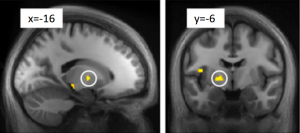Jul 29 2014
Reward and Punishment in the Brain
 In a recent study, scientists looked at the brain with high resolution fMRI scanning while they showed subjects pictures. Following each picture was a painful electric shock, or a money reward, or no response, or a random response. Subjects quickly learned which pictures would be followed by which stimuli – positive, negative, neutral, or unpredictable.
In a recent study, scientists looked at the brain with high resolution fMRI scanning while they showed subjects pictures. Following each picture was a painful electric shock, or a money reward, or no response, or a random response. Subjects quickly learned which pictures would be followed by which stimuli – positive, negative, neutral, or unpredictable.
Scientists do this sort of thing not because they like to torture people but to study the brain’s response. In this case they were particularly interested in a small deep structure called the habenula. What they found, for the first time in humans but consistent with prior animal research, is that the habenula would light up when subjects saw a picture that would be followed by a shock, and the activity in the habenula increased the more certain the subjects were that negative stimuli were following.
The researchers conclude that the habenula is a critical structure for the processing of negative stimuli, in fact it seems to be the hub of the neural network involved in learning to anticipate negative stimuli.
I have to point out this is one study, and fMRI research is tricky business. But the methods seem rigorous and the results robust. Assuming the results replicate, what are the implications of this finding?
Specifically this helps us understand the neuroanatomical correlates of predicting negative outcomes. In animal research, hyperactivity in the habenula has been associated with depressive behavior. Further, deep brain stimulation of this structure has been used to treat depressive symptoms.
People suffering from depression spend more time and mental energy focused on the negative, worrying about and anticipating negative outcomes. Part of the depression syndrome, at least in a subset of individuals, may be due to (or at least involve) hyperactivity in the habenula.
Placing this one study in a broader context, this fits with our working understanding of neuroscience in various ways. One core aspect of our interaction with the environment is remembering and associating positive and negative stimuli, and changing our behavior accordingly. We don’t want to get anywhere near the hungry predator, but we will want to follow the scent of ripening fruit.
The habenula is highly conserved among vertebrates, so most animals with central nervous systems have a habenula, indicating that it is both primitive and essential.
Another big-picture lesson is that everything in the body that can go wrong, does. There is a disease or disorder associated with just about every bodily function we know about (unless such dysfunction would be incompatible with life). The brain is no exception (why should it be?).
In this case we might think of certain brain disorders as a problem of calibration. Optimally, the habenula and the network to which it connects should be finely tuned so that negative stimuli produce a functionally optimal response in the brain. We want to remember and avoid risks for negative outcomes, and our motivation should be proportional to the risk.
This is, in fact, what people experience in everyday life – we experience everything from mild concern to abject terror, and usually the emotional response is reasonably proportional to the actual risk. When fear and worry are grossly out of proportion to reality, we recognize that as a problem and may refer to it as a phobia.
When someone is overly focused on the negative in general, to the point that they cannot enjoy life or focus on the positive, they are pathologically depressed.
These are problems of calibration. Perhaps one day we will develop the technology to recalibrate the habenula and similar structures so that they operate within more functional parameters. In the shorter term, we may be able to use deep brain electrical stimulation to simply suppress the activity in the habenula. This is crude, but may be effective.
I am deliberately using mechanical terms to emphasize that the brain is a machine (albeit a highly complex one). This brings me to another basic lesson – modern neuroscience has taught us that our brains are just complex machines. Everything you think, feel, remember, etc. is happening in the brain, which has specific modules and networks dedicated to such functions.
The dualists are simply wrong when they say the materialist paradigm is dead. They are making this up. Neuroscientists are happily ignoring the dualists, and proceeding as if the mind is what the brain does. They are searching for neuroanatomical correlates of mental function, secure in the premise that everything the mind does must be happening in the brain. So far this approach has been fantastically successful.
Conclusion
This latest study advances our understanding of the brain one baby step, but it is noteworthy. It supports the notion that the habenula is critically involved in remembering and associating predictors of negative stimuli.
As our technology to hack the brain improves, such knowledge will become increasingly of practical value. It seems likely that we will eventually develop the ability to directly affect the activity of the habenula in order to treat, or even cure, some major depressive disorders.
Meanwhile it is one more data point to add to the brain mapping project.






